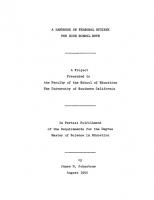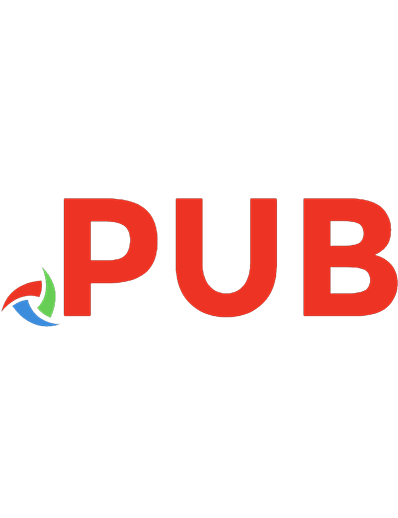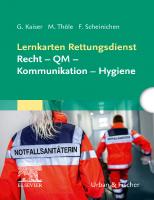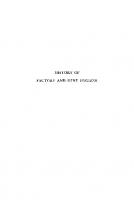Personal Hygiene [8]
175 22 16MB
English Pages viii,232 [256] Year 1907
Polecaj historie
Table of contents :
Title Page
Contents
Editor's Note
Letter to Students
Precepts for Right Living, by Ellen H. Richards
Introduction
The Human Machine
Structure of the Body
The Bones
The Muscles
The Nervous System
The Skin and Connections
The Sense Organs
The Sense of Sight
The Sense of Hearing
Running the Machine
Digestion of Food
The Blood
The Circulation
Respiration
Nutrition
Temperature Regulation
Elimination
Care of the Machine
Hygiene of the Nervous System
Hygiene of Feeding
Care of the Teeth
When, How Much, and What to Eat
Drink
Hygiene of the Skin and Its Modifications
Baths
Care of the Hair
Care of the Complexion
Care of the Mucous Membrance—Colds
Hygiene of Clothing
Shoes
Physical Exercises
Ethics of Health, by Thomas D. Wood, M. D.
The Use and Abuse of Drugs, by H. M. Lufkin, M. D.
Public Health in the United States
Plea for a National Department of Health, J. Pease Norton, Ph. D.
Program for Supplemental Study
Index
Citation preview
i
oi
pany
i
ical
ithe
Sign e ecient beta
tite Deo
BiG satett ait
fH :
Ha
at
i
i
i
es
fat
attics
ei
H
ath PtrpL
SE
BAe
te
te a
ae st thea ie
Uta
1
eeu
i
Car ee tee iba
Peart hs oT) rant
trate
‘
fty
eee
Cura art iii Nui
i
a
Pi WalyG ot rf
: :
.
Wu
ruta
Hh
be
"
oie Chr nh: Darin . AR ie oh Ae SL tHE
aa sae rr eae pie patna s
;:
|
rane Bapeel.) rents
Ser urabicaraty Not
HARE
it
ity
Orit
Chau
tea heit he
of .
>
Ds
College
eau
Ace No BL GeO
3) BF csasrrracestbeatdeaninorsepepionse nna ea a
bEalbzalb=4]bs4]bsa]bzalbsalbs4|bs4|bsa]p=albealbs4|bs4]bsa|psal
p @
((, 4 f=
niica
‘
PON
a
ny
z
S
.
‘
.
tin ih wel iy
.
;
.
.
ANON
ASSN?
Mander
4
.
.
Se
-
,
MS
“
a WOME
\AN MAL,aN
\
me
~
ay
(veers
tn it
NNU SoA AL
IVyhi, re
SaET )
446 ak ?
}
Sw)
i!
LE it ANN
THE LIBRARY
HOME ECONOMICS A COMPLETE ON
THE THE
NEW
PROFESSION
PRACTICAL IN THE
OF
HOME-STUDY HOME-MAKING
APPLICATION
ARTS
AND
OF
SCIENCES
COURSE
AND
THE
MOST
TO
HOME
ART
OF
RECENT AND
RIGHT
LIVING,
ADVANCES
HEALTH
PREPARED BY TEACHERS OF RECOGNIZED AUTHORITY FOR ?
HOME-MAKERS,
MOTHERS,
PROFESSIONAL IN
HOUSE
HOME,
TEACHERS,
HEALTH,
ECONOMY
TWELVE NEARLY
THREE TESTED
THOUSAND BY
USE
IN
REVISED
PHYSICIANS,
MANAGERS,
AND AND
NURSES,
CHILDREN
ONE
THOUSAND
CORRESPONDENCE
ILLUSTRATIONS
INSTRUCTION
SUPPLEMENTED
CHICAGO AMERICAN
SCHOOL
DIETITIANS,
INTERESTED
VOLUMES
PAGES, AND
ALL
OF
1907
HOME
ECONOMICS
COPYRIGHT, HoME
BY ECONOMICS
I907 ASSOCIATION
Entered at Stationers’ Hall, London All Rights Reserved.
2333
AUTHORS ISABEL BEVIER, Ph. M. Professor of Household Science, University of Illinois. Author U.S. Government Bulletins, ‘‘ Development of the Home Economics
Movement in America,” etc.
AEICE *PELOUBET
NORTON,
M.A.
Assistant Professor of Home Economics, School of Education, Unioo of Chicago; Director of the Chautauqua School of Domestic cience.
S., DEARTA CE ELIOPT Instructor in Home Economics, Simmons tor School of Housekeeping, Boston.
ANNA
College; Formerly Instruc-
BARROWS
Director Chautauqua School of Cookery; Lecturer Teachers’ College, Columbia University, and Simmons College; formerly Editor ‘‘American Kitchen Magazine,” Author ** Home Science Cook Book.”
ALFRED
CLEVELAND
COTTON,
A. M.,.M. D.
Professor Diseases of Children, Rush Medical College, University of Chicago; Visiting Physician Presbyterian Hospital, Chicago; Author of ‘* Diseases of Children.”
BEREHA OM. TERRILI. A.B. Professor in Home Economics in Hartford Author of U.S. Government Bulletins.
KATE
HEINTZ
School
of Pedagogy;
WATSON
Formerly Instructor in Domestic Economy, Lewis Institute; Lecturer
University of Chicago.
MARION
FOSTER
WASHBURNE
Editor “‘The Mothers’ Magazine;”’ Lecturer Chicago Froebel ciation; Author ‘‘ Everyday Essays,” ‘‘ Family Secrets,” etc.
Asso-
MARGARET E. DODD Graduate Massachusetts Institute of Technology ; Teacher of Science, Woodward Institute.
AMY
ELIZABETH
POPE
With the Panama Canal Commission; Formerly Instructor in Practical and Theoretical Nursing, Training School for Nurses, Presbyterian Hospital, New York City.
MAURICE
LE BOSQUET,
S. B.
Director American School of Home Economics; Member American - Public Health Association and American Chemical Society. 2
CONTRIBUTORS
AND
EDITORS
ELLEN H. RICHARDS Author ‘‘ Cost of Food,” ‘‘ Cost of Living,” ‘* Cost of Shelter,” ‘‘ Food Materials and Their Adulteration,” etc., etc.; Chairman Lake Placid Conference on Home Economics.
MARY
HINMAN
ABEL
Author of U.S. Government Bulletins, ‘‘ Practical Sanitary and Economic Cooking,” ‘Safe Food,” etc.
THOMAS
D2] WOOD
MA. BD:
Professor of Physical Education, Columbia University.
HU ANCE LURKING
Nie:
Professor of Physical Diagnosis and Clinical Medicine, University of Minnesota.
OTTO
FOLIN;
Ph. BD:
Special Investigator, McLean Hospital, Waverly, Mass.
T. MITCHELL
PRUDDEN,
M. D., PED:
Author ‘‘Dust and lts Dangers ” ‘‘The Story of the Bacteria,” “‘Drink-. ing Water and Ice Supplies,” etc.
FRANK
CHOUTEAU
BROWN
Architect, Boston, Mass.; Author of ‘‘The Five Orders of Architecture,” ‘‘ Letters and Lettering.”
MRS.
MELVIL
DEWEY
Secretary Lake Placid Conference on Home Economics.
HELEN
LOUISE
JOHNSON
Professor of Home Economics, James Millikan University, Decatur.
FRANK]
W2-AEREIN,
ENE 2D.
Instructor Rush Medical College, University of Chicago.
MANAGING MAURICE
LE,BOSOUE
EDITOR T7548:
Director American School of Home Economics.
BOARD OF TRUSTEES OF THE AMERICAN SCHOOL OF HOME ECONOMICS MRS.
ARTHUR
COURTENAY
NEVILLE
President of the Board.
MISS
MARIA
PARLOA
Founder of the first Cooking School in Boston; Author of ‘Home Economics,” ‘‘ Young Housekeeper,” U. S. Government Bulletins, etc.
MRS.
MARY
HINMAN
ABEL
Co-worker in the ‘* New England Kitchen,” and the “Rumford Food Laboratory;” Author of U. S. Government Bulletins, * Practical Sanitary and Economic Cooking,” etc.
MISS ALICE RAVENHILL Special Commissioner sent by the British Government to report on the Schools of Home Economics in the United States; Fellow of the Royal Sanitary Institute, London.
MRS. ELLEN M. HENROTIN Honorary President General Federation of Woman’s Clubs.
MRS. FREDERIC W. SCHOFF President National Congress of Mothers.
MRS.
LINDA
HULL
Past President National of ‘* Hostess ot To-day.”
MRS.
WALTER
LARNED Household
McNAB
Economics Association; Author
MILLER
Chairman of the Pure Food Committee of the General Woman's
MRS.
Clubs.
Federation
of
J. A. KIMBERLY Vice President of National Household Economics Association.
MRS. JOHN HOODLESS Government Superintendent of Domestic Science for the province of Ontario; Founder Ontario Normal School of Domestic Science, now the MacDonald Institute.
VENUS
DE
MILO
PERSONAL
HYGIENE
EDITED
MAURICE: DIRECTOR MEMBER
AMERICAN AMERICAN
AMERICAN
BY
LE BOSQUET; SCHOOL PUBLIC
OF
HEALTH
CHICAGO SCHOOL OF HOME
1907
S. B.
HOME
ECONOMICS
ASSOCIATION
ECONOMICS
COPYRIGHT, 1907 BY HOME
ECONOMICS
ASSOCIATION
Entered at Stationers’ Hall, London All Rights Reserved,
CONTENTS LETTER
TO STUDENTS
PRECEPTS
FOR RicuT
.
LIVING, by Ellen H. Richards
INTRODUCTION THE Human MACHINE Vv STRUCTURE OF THE Bopy THE BONES THE MUSCLES : : 5 THE NERVOUS SYSTEM THE SKIN AND CONNECTIONS THE SENSE ORGANS THE SENSE OF SIGHT . :
THE
SENSE
/RUNNING
OF HEARING
2
;
.
THE MACHINE
DIGESTION OF Foop . ; THE BLoop . ; : : : THE CIRCULATION. : F RESPIRATION ; : ; : NUTRITION : : TEMPERATURE Rrevencian ELIMINATION RARE OF THE MACHINE “HYGIENE OF THE NERVOUS Cyan HYGIENE OF FEEDING CARE OF THE TEETH WHEN, How Mucu, AND Were TO Eee DRINK. HYGIENE OF THE Sicriy AND BatTus ; : : CARE OF THE HAIR : CARE OF THE COMPLEXION
Tie Morimierrtine s iii
vi Vili
13 15 19 24 29 33 39 47 51
66 68 75 81
94 98
105 106 I14 114 121 135 ee) 138 141 145
iv
CONTENTS
CARE OF THE Mucous HYGIENE
SHOES .
MEMBRANCE—COLDS
OF CLOTHING.
’
:
:
;
Asya
:
tes
.
T49 153
‘
:
:
:
PuHysICAL EXERCISE Rate Mara : ‘ E Etuics oF H::attuH, by Thomas D. Wood, M. D. THE UsE AND ABUSE OF Drucs, by H. M. Lufkin, M. D. Puspiic HEALTH IN THE UNITED STATES A : PLEA FOR A NATIONAL DEPARTMENT OF HEALTH,
J.. Pease Norton, Ph. D. . PROGRAM FOR INDEX :
SUPPLEMENTAL 4 ; ‘
:
:
STUDY : ‘
‘
158 161 IgI 202 216
222 225 229
EDITOR’S
NOTE
Arrangements were originally made to have this series of lessons on Personal Hygiene prepared by Professor Thomas D. Wood of Columbia University. An operation for appendicitis, resulting seriously, compelled him to abandon all work for nearly two years, consequently the preparation of the lessons was turned over to his co-worker, Dr. George L, Meylan, whose manuscript followed after some time. Mean-
while, the whole
course
had developed
in length,
breadth,
and depth and the work on Personal Hygiene was found to be too elementary and not to fit into its particular niche in the enlarged scheme. As Dr. Meylan could not give the
time
for revision,
he
asked
to be
released
from
further
responsibility of authorship. After endeavoring in vain to induce half a dozen others to write the book in the time set, the editor was compelled to
undertake the difficult task himself, with such assistance as
could be obtained. Dr. Meylan’s material has been drawn upon, especially in Part I, but the subject-matter has been rearranged and for the most part rewritten. All the up-to. date books on the subject—a meager list—have been consulted, and ideas borrowed freely. For the latest facts in physiology I have depended mainly on A Text-Book of Physiology by Professor William H. Howell of the Johns Hopkins University, Recent Advances in Phys-
tology and Bio-chemistry, edited by Leonard Hill, Pawlow’s classic book, The Work of the Digestive Glands, and the
ately published college text-book, The Human M echanism, by Professors Hough and Sedgwick. I wish to make grateful acknowledgment for help and suggestions given by Mrs. Ellen H. Richards and Miss S. Maria Elliott, to Miss Helen Louise Johnson for assistance
in editorial work, and to Dr. Frank W. Allin of Rush Medical
College for checking the technical statements Chicago, December, 1906. Vv
in the text.
AMERICAN SCHOOL OP HOME ECONOMICS 3323 ARMOUR AVENVE CHICAGO
January Dear
.Pelo0ds.
Madan:
As the lessons on Personal Hygiene have been so long delayed, many of our students have about completed their courses. Nearly all the letters received giving the reason for slow progress speak of personal ill health or sickness in the family, and I realize now more clearly than ever before that these lessons should form the keystone
in the arch of health which to build with our course.
we are
trying
I undertook the preparation of these lessons with full recognition of the difficulties of the subject. If I might have had two years instead of two months to write them, the result might have been more satisfactory to me. The words to carry conviction and compel action are hard to find.
Personal
health
is so necessary,-few
things are worth while without it. It is above price and cannot be bought with money-it must be worked for like nearly everything else worth having. Its value is hard to realize until lost and then it may be too late. The tragedies, the sorrows, the heart aches that come from lack of knowledge and lack’of self control in, ithe matters of healtheare beyond reckoning.
I hope these lessons may be only the beginning of your study of personal health. Follow the "Supplemental Program" if possible. In problems of health the application of
principles must always be a most personal One. Ot course here as elsewhere it isa mistake to look for trouble--to expect things to go wrong. The hypochondriac never fails to find looked for ills. We must live in faitn. Nature takes wonderful care of us if we will only give her co- operation. Put yourself into your answers and give expression to your own ideas. Ask questions freely and so allow me to supplement the lessons. I may not be able to answer all your questions but perhaps can give a little more help. Of course advice in cases of illness cannot be given at "pen and ink distance."
Sincerely
yours,
Instructor
»
Right Living Live
to accomplish
something—not merely
to exist.
To live means to eat, to work, to sleep, to be amused
and refreshed after work. Eat for satisfying
legitimate hunger of the body cells
—not only to please the palate.
Sleep for restoration
of energy—see
to it that such
1s the result.
Exercise is as essential as sleep—learn what and how much shakes out the dead ashes from the living
coals. Life processes go on best unwatched.
a stage —enjoy
‘All the world’s
the play.
Live for a worthy purpose—-some incentive, some goal to reach keeps the traveller on the safe road. | Adapt
habits
to
environments,
control surroundings
as far as possible to the great end—effective life. Educate the young
from the first to value life and
health, to find happiness in right living.
Above
all, believe
that it pays to know
and to follow it.
the truth
Nb Medel
PERSONAL
HYGIENE
YGIENE is the technical application of biology and physiology to the problem of health. The old dictionary definition of Hygiene, which stated it to be “that which has to do with the preservation and restoration of health” has of later years given way to a higher ideal, and we may define it now as “that
Definition
which has to do with the preservation and improvement of health.” Most people consider themselves well as long as they are not ill and do not consciously endeavor to better their physical condition, but those who have interpreted anew the definition of hygiene seek the higher geal’) A most important factor in the study of health is an appreciation of the value of health. This means much more than merely to wish one’s self well. It involves a realization that the first and most important duty is to be well. The second factor is the willingness to do anything that is necessary to acquire ideal health. Many are willing to be patient, to take time, money and trouble to regain the blessing of health once lost; few are found willing to do all this to attain a higher standard.
Value of Health
2
Economy of
espe oreonal or Health
PERSONAL
HYGIENE
The third factor is in a measure involved in the second, but needs to be stated more forcibly. It is the realization that the time and strength and money used for the improvement of health are not taken fromgreater or more necessary things, but that health is a fundamental necessity. Some do accomplish much in spite of physical limitations and many who seem to be fine physically have never achieved greatness elsewhere. But it remains that to do one’s best it is nese to be one’s best. Finally the personal responsibility for health should be appreciated. Health is the natural condition of the body. The organism is constantly endeavoring to maintain itself in this normal state and it is only when |
conditions are so unfavorable that the body cannot adjust itself to them that illness results and the organism demands rest for recuperation. Statistics show that only ten per cent of mankind die from natural causes,—the wearing out of the machine through old age. It is safe to say that poor health and illness result in nine cases out of ten from ignorance, carelessness, or intemperance of some kind, Most people have certain notions and theories as to the requirements for personal health, but very few have studied the subject systematically in the light of present-day scientific developments. Knowledge of personal hygiene is not yet considered an essential part of a liberal.education.
Few people live up to the knowledge that they have
INTRODUCTION
i
nh
of healthful living, but a falling short of ideals is com-
mon in all lines of human endeavor. What is needed is greater knowledge and higher ideals. Much illness results from carelessness, for all contagious or infectious diseases (communicable diseases) are preventable. As far as known, each case comes from some previous case, near or remote, so that all such illness may be attributed to carelessness and ignorance, chiefly perhaps of those who are ill or their attendants, but often through lack of ordinary precaution on the part of those contracting communicable disease. The body in perfect health is a fortress against the invasion of the germs of disease,
Preventable Diseases
_ but some seemingly trivial weakness may give the germs the chance to develop and affect their dread results. Intemperance has many forms besides the over indulgence in alcoholic liquors. Intemperance in eating is probably as common and nearly as disastrous. We may be intemperate in work as in play. The individual “strength of constitution” so called, differs greatly, it is true. Each one has his personal - limitations and these should be studied, but a certain
measure of health is possible for everyone who is will-
ing to work for it, unless the attempt is made too late.
Through childhood the mother is chiefly responsible for the health of the child, after which each individual is alone responsible for maintaining the degree of
health that he has and improving upon it. That a poor
Intemperance
Personal Limitations
4
Health and Happiness
PERSONAL
HYGIENE
constitution may be improved greatly and oftentimes developed into a vigorous one has been proved repeatedly. A notable example is that of President Roosevelt who when a youth was unpromising physically. But as man is more than animal and has a mental and spiritual life as well as a physical life, these must be considered in any study of right living. As there can be no perfect happiness without physical health, so there can be no perfect physical health without the mental and spiritual health which gives happiness, and. further, this higher health depends upon a true philosophy of life, a proper adjustment between work and recreation, some purpose in living, service, ideals. The problem of right living is always one of adjustment and it is necessary to know as much about | the body as possible to make the most perfect adjustment to the ever-increasing complexity of modern life. In this series of lessons we shall study something of
(1) The Human Machine, (2) The Running of the Machine, and (3) Care of the Machine.
THE
HUMAN
MACHINE
The human body is a living machine in that the function of a machine is simply to convert one kind
of energy into another.
This is precisely what the
body does. Biology is concerned with the origin of this machine, physiology with the running of it. The facts discovered in connection with the organic cell and protoplasm seem to hold the key to the interpretation of the life phenomena. Life itself is inex-
plicable.
Yet what we believe to be true of the origin
of the living machine assists us in the difficult task of properly adjusting this organism to its environment.
If we compare a dead body with a living one, we find the form the same, the weight the same; if we
Nature of ife
analyze them chemically, we still find them the same. Yet we know there is an essential difference between the two and that difference is given by a wonderful something called life. A living body has the property of movement, takes in food and builds it into living tissue, reacts to its surroundings,
maintains
an even
temperature, reproduces itself, and finally dies. All living things from the lowest to the highest forms are called organisms. One of the lowest forms of animal life is a little body found in muddy water, called the amceba. This small organism is barely visible to the naked eye and if looked at under the microscope appears like a tiny round mass of jelly. 5
Organisms
6
PERSONAL
HYGIENE
But this very small body moves about, takes in food, changes that food into living substance, and grows; it responds if irritated; it reproduces itself, and finally it dies. This tiny mass, therefore, has all the properties of a living organism.
\
THE
Unit Cells
AMOEBA,
A TYPEOF
A UNICELLULAR
ORGANISM
If we cut the amoeba into several pieces, we find that each part is like every other part. This represents the simplest possible living thing capable of an independent existence. It is a single cell. The study of the amoeba is interesting because the human body is developed from a single cell called an ovum which is very similar to the amceba. The process of develop-
ment may be divided into three stages. Be oelapment
In the first stage the ovum or cell divides into two
Ovum
cells and each again divides into two until there are
‘many cells all alike, which are held together and form a mass something like the little round parts making up a raspberry. Up to this point each cell is like every other cell.» | The change that takes place in the second stage has been likened to the transformation of a savage into a civilized man. The savage lives an independent life; he procures his own food, makes his clothes, builds his hut, and fights his own battles. Little by little, one
7
ae a
ee
Ne
AN Te te ee
THE
Po a
HUMAN
——o_O
ee ee
MACHINE
©
7
man finds that he can build huts better than other men and he builds a hut for another man who is a successful hunter, and exchanges the hut for food. In the same way one man is very skillful in making clothes and he makes the clothes for a man who makes very good tools. Gradually differentiation of labor
takes place; that is, one man learns to do one thing well and does that only, while other men do the things for which they are best fitted. A condition: very similar to this division of labor takes place in the second and third stages of the de-
BODY CELLS. 4, Muscle Cells; 2, Liver Cells; C, White Corpuscles; £, Nerve Centers or Cells.
Differentiation nee
D, Ciliated Cells;
velopment of the full grown man from the mass of similar cells. At the first stage, each cell is like the savage who does everything for himself. As the cells. ,t-






![Psychologie der Hygiene [1 ed.]
9783798518605](https://dokumen.pub/img/200x200/psychologie-der-hygiene-1nbsped-9783798518605.jpg)


![Multiresistente Erreger: Diagnostik - Epidemiologie - Hygiene - Antibiotika-„Stewardship" [2. Aufl.]
978-3-662-58212-1;978-3-662-58213-8](https://dokumen.pub/img/200x200/multiresistente-erreger-diagnostik-epidemiologie-hygiene-antibiotika-stewardshipquot-2-aufl-978-3-662-58212-1978-3-662-58213-8.jpg)
![Personal Hygiene [8]](https://dokumen.pub/img/200x200/personal-hygiene-8.jpg)